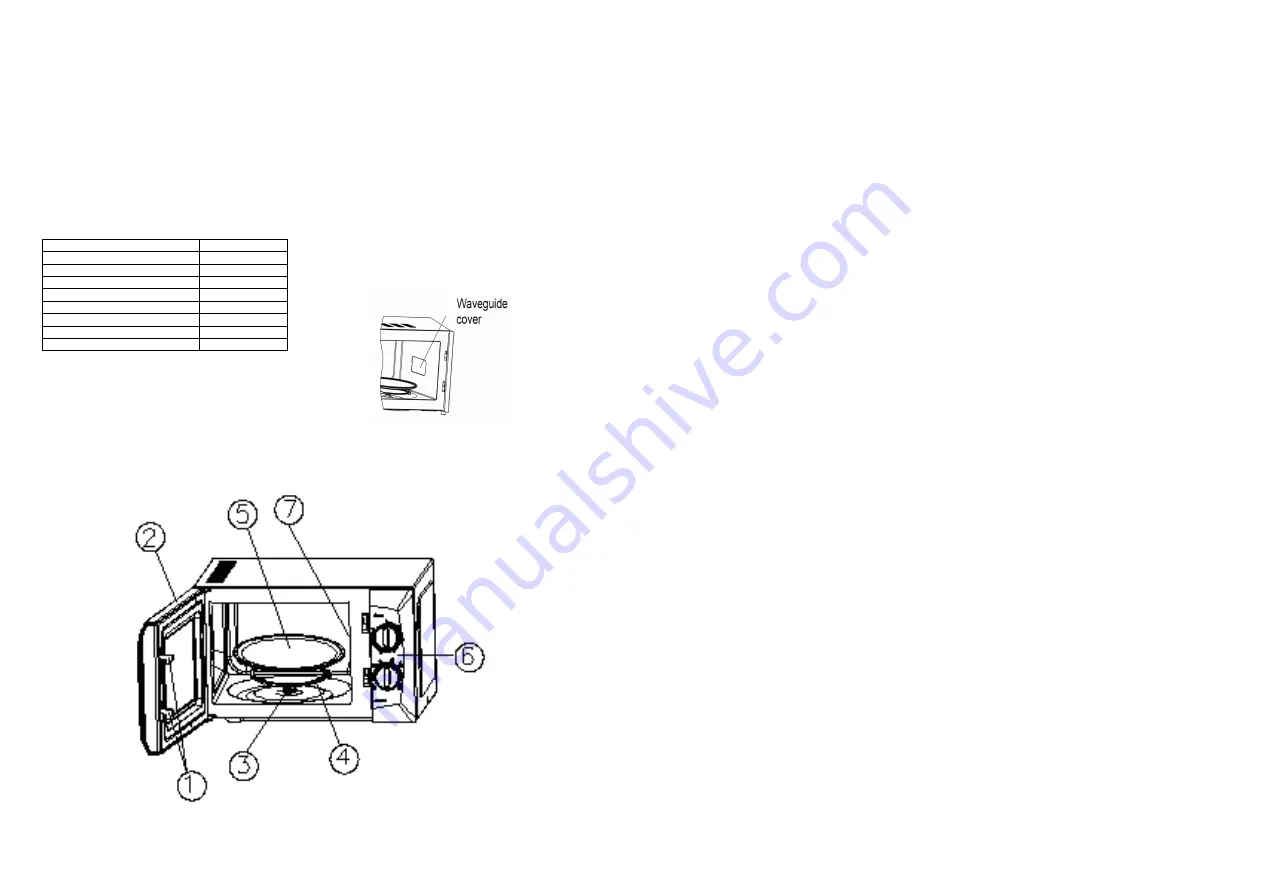
4
5) The appliance must be positioned so
that the plug is accessible.
6) The microwave oven is intended to be
used freestanding and shall not be placed
in a cabinet.
7) To keep the microwave oven at a
distance from the wall, it is necessary to
install a distance limiter.
UTENSILS GUIDELINE
Before use, check whether the utensils
used are suitable for cooking in this
microwave oven. Please take the table
below for your reference. In the table,
“
○
“ means applicable, while “ X ” not
applicable.
Material of container
Microwave
Heat-resistant glass
○
Ceramic
○
Ordinary glass
X
Heat-resistant plastic
○
Ordinary plastic
X
Thin Plastic film
○
Metal Grill
X
Metal container
X
FOR THE FIRST USE
As there is manufacturing residue or oil
remained on the oven cavity or heat
element, it usually would smell the odor,
even a slight smoke. It is a normal case
and would not occur after several times
use, keep the door or window open to
ensure good ventilation.
PRODUCT INSTRUCTION
1) Door interlock - Ensure that
microwave oven can only be activated
when the door is properly closed.
2) Viewing window - Cooking status
can be viewed through metal mesh.
3) Rotating axis - Drive the glass
turntable rotating.
4) Rotating ring - Support the glass
turntable.
5) Turntable - It turns to make food
heated
evenly
when
cooking,
recommend using it when cooking. So it
is strongly recommended to place a cup
of water in the turntable and set at high
power and operate for several times.
Household use only
6) Control panel - See below in details
(the control panel is subject to change
without prior notice).
7) Wave guide cover (inside)
WARNING: Never remove it during
cleaning. See fig.1
5
IMPORTANT SAFEGUARDS
The following basic precautions should
always be followed when using electrical
appliance:
1. Read all instructions before using.
2. Make sure the voltage in your living
area corresponding to the one shown on
the rating label of the appliance. And the
wall socket is properly grounded.
3. To reduce the risk of fire in the oven
cavity:
a. Do not overcook the food.
b. Remove wire twist-ties from paper or
plastic bags before placing bags in the
oven.
c. Do not heat oil or fat for deep drying as
the temperature of oil cannot be
controlled.
d. After use wipe the waveguide cover
with a damp cloth, followed by dry cloth
to remove any food splashes and grease.
Built-up grease may overheat and begin to
cause smoke or catch fire.
e. If materials inside the oven should
smoke or ignite, keep oven door closed,
turn oven off and disconnect the power
supply.
f. Close supervision is necessary when
using disposable containers made from
plastic, paper or other combustible
material.
4. To reduce the risk of explosion and
sudden boiling:
a. Do not place sealed containers in the
oven. Baby bottles fitted with a screw cap
or teat are considered to be sealed
containers.
b. When boiling liquid in the oven, use the
wide-mouthed container and stand about
20 seconds at the end of cooking to avoid
delayed eruptive boiling of liquids.
c. Potatoes, sausage and chestnut should
be peeled or pierced before cooking. Eggs
in their shell, whole hard-boiled eggs
should not be heated in microwave ovens
since they may explode, even after
microwave heating has ended.
d. The cooked liquid should not be
removed
out
immediately.
Several
moments should be waited before
removing In order to avoid possible
hazards caused by delayed eruptive
boiling of liquids.
e. The contents of feeding bottles and
baby food jars are to be stirred or shaken
and the temperature is to be checked
before consumption, in order to avoid
burns.
5. Never operate the oven further if the
door or door seals are damaged or the
oven is malfunctioned or supply cord is
damaged. Return the appliance to the
nearest authorized service center for
repair and maintenance. Never try to
adjust or repair the oven yourself.
6. If the supply cord is damaged it must
be replaced by the manufacturer or its
service agent or a qualified technician in
order to avoid a shock hazard.
7. After cooking, the container is very hot.
Using gloves to take out the food and
avoid steam burns by directing steam
away from the face and hands.
8. Slowly lift the furthest edge of dishes
cover and microwave plastic wrap and
carefully open popcorn and oven cooking
bags away from the face.
9. To prevent the turntable from
breaking:
a. Let the turntable cool down before
cleaning.
b. Do not place hot foods or utensils on
the cold turntable.
c. Do not place frozen foods or utensils on
the hot turntable.
10. Make sure the utensils do not touch
the interior walls during cooking.
11. Failure to maintain the oven in a clean
condition could lead to deterioration of
the surface that could adversely affect
the life of the appliance and possibly
result in a hazardous situation.
12. Only use utensils that are suitable for
use in microwave ovens.
13. Do not store food or any other things
inside the oven.
14. Do not operate the oven without any
liquid or food inside the oven. This would
do damage the oven.
15. This appliance is not intended for
using by young children or infirm persons
without supervision.
16. Any accessories not recommended by
the manufacturer may cause injuries to
persons.
17. Do not use outdoors.
18. Save these instructions.
19. This appliance is not intended for
used by persons (including children) with
reduced physical, sensory or mental
capabilities, or lack of experience and
knowledge, unless they have been given
supervision or instruction concerning use
of the appliances by a person responsible
for their safety. Children should be
supervised to ensure that they do not
play with the appliance.
20. The appliance is not intended to be
controlled by an external timer or
separate remote-control system.





















